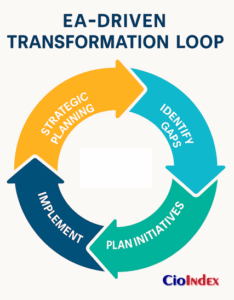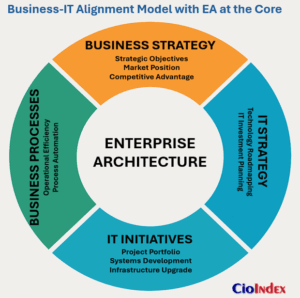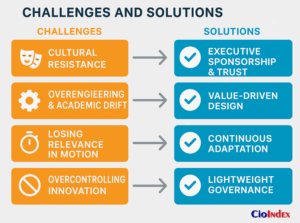Enterprise Architecture as Strategy is a concept, popularized by the book Enterprise Architecture as Strategy by Jeanne W. Ross, Peter Weill, and David C. Robertson, that treats EA as a strategic tool for shaping the organization’s operating model and driving competitive advantage.
Strategy doesn’t collapse at the planning table—it unravels where execution begins. Where objectives splinter, systems drift, and operational demands overwhelm strategic intent. Every initiative, from digital platforms to customer experience overhauls, depends on one critical factor: alignment between what the business envisions and what technology delivers. Without it, even the most ambitious transformations lose their way.
Alignment isn’t automatic. It’s fragile. It demands discipline, architecture, and shared vision to survive the turbulence of operational reality.
Enterprise Architecture provides that foundation. It weaves business goals into the structures, technologies, and capabilities that bring them to life. EA doesn’t just map the enterprise—it synchronizes it. It ensures that technology doesn’t just support the business—it advances it. That every investment, system, and decision points toward a coherent future state.
In a previous article, we explored enterprise architecture’s evolution, purpose, and value to the enterprise. In this article, we move forward to examine how EA acts as the engine of business-IT alignment. We’ll look at why misalignment persists even in transformation-era enterprises, how EA builds the connective tissue organizations need, and what practices keep architecture grounded in business value. For deeper models and alignment playbooks, explore our membership guides crafted for enterprise leaders building sustainable success.
Understanding IT and Business Alignment
Definition
Alignment isn’t about agreeing on project plans. It’s about engineering a shared trajectory—where IT systems, business processes, and technology investments directly reinforce strategic goals. It’s the tight coupling of action with ambition. When alignment is strong, technology doesn’t just support the business—it amplifies it. When it’s weak, even the most sophisticated systems end up solving the wrong problems.
In a fully aligned enterprise, every digital initiative, from application rollouts to data modernization programs, is traceable to a business outcome. Architecture becomes the connective logic that keeps execution and intent synchronized across every layer of the organization.
Why It’s Historically Difficult
Alignment sounds simple. In practice, it rarely is. Enterprises accumulate complexity, and with it, drift.
Different Priorities
Business and IT have often moved to different rhythms. Business leaders chase growth, market share, and customer loyalty. IT leaders optimize for efficiency, stability, and scalability. Both objectives are valid—but without a unifying architectural framework, they pull the enterprise in different directions.
Communication Gaps
Shared intent requires shared language. Yet too often, business and technology teams operate with different vocabularies, different assumptions, and different measures of success. Strategy becomes lost in translation, and technology decisions drift away from business needs.
Siloed Operations
Organizational silos reinforce misalignment. When departments define priorities independently, investments fragment, systems duplicate, and architectures sprawl. Without cross-functional coordination, even well-intentioned initiatives compound operational incoherence.
The result is an enterprise where strategy is declared but not delivered. Where transformation becomes a patchwork of projects, rather than a coherent movement toward a unified goal.
Why Alignment Matters Now
What was once a structural inefficiency is now a strategic liability. In today’s environment, misalignment isn’t just costly—it’s existential.
Digital Transformation Blurs the Lines
Business and IT can no longer afford to operate in parallel. Technology is business. From customer experience to supply chain optimization, digital capabilities are inseparable from how enterprises create and deliver value. Alignment is no longer a competitive advantage—it’s a baseline requirement.
Competitive Advantage is Technology-Driven
Markets move faster than planning cycles. Innovation windows shrink. Enterprises that align technology capabilities with business strategy can move with precision and speed—launching new products, entering new markets, and adapting operations ahead of competitors. Those that don’t, fall behind.
Customer Expectations Demand Seamless Experiences
Customers don’t distinguish between business strategy and IT infrastructure. They expect seamless, personalized, technology-enabled experiences—across every channel, every interaction. Delivering that cohesion requires deep alignment between what the business promises and what technology enables.
Without structural alignment, enterprises don’t just risk project failures—they risk strategic failure. And in a digital economy, strategic failure is unforgiving.
Misalignment doesn’t just slow execution or erode efficiency — it compounds enterprise risk. Projects overrun. Customer experiences fracture. Systems drift into expensive irrelevance. Without architecture as the anchor, strategy unravels under operational pressure.
How Enterprise Architecture Facilitates Alignment
Alignment doesn’t happen by intention alone. It requires structure. It requires mechanisms that translate ambition into coherent action across systems, teams, and investments. That’s where Enterprise Architecture moves from concept to catalyst.
EA doesn’t just describe the enterprise—it designs it for alignment. It embeds the business’s strategic intent into the very fabric of its operations, ensuring that decisions made in projects, portfolios, and platforms remain tethered to enterprise goals.
Enterprise Architecture facilitates alignment through four essential levers:
Providing a Shared Vision
Most misalignment begins with fragmented perspectives. Business units chase departmental KPIs. IT teams optimize for technical efficiency. Without a unifying vision, efforts diverge—and so does value.
Enterprise Architecture creates a common blueprint. It maps how strategy flows into capabilities, capabilities into systems, and systems into outcomes. It provides a single source of truth that guides both business and technology leaders toward the same future state.
With a shared vision, alignment moves from aspiration to architecture. Every team can see where they are headed—and how their contributions fit the larger design.
Enabling Strategic Planning
Strategy without architecture is guesswork. It leads to investments that duplicate efforts, projects that clash with each other, and systems that undercut the very agility enterprises seek.
Enterprise Architecture grounds strategic planning in operational reality. It translates high-level objectives into actionable roadmaps, transition states, and architectural patterns. It forces critical questions: Which capabilities matter most? Which dependencies must be addressed first? What architectural trade-offs are acceptable—and which ones are fatal?
By anchoring planning in architectural logic, EA ensures that strategy isn’t just set—it’s built.
Enhancing Decision-Making
Every decision—whether about adopting a new platform, retiring a legacy system, or reorganizing a business process—carries architectural consequences. Without visibility into those consequences, enterprises make fragmented moves that add complexity instead of reducing it.
Enterprise Architecture makes decision-making structural, not opportunistic. It provides frameworks, models, and impact assessments that illuminate the downstream effects of choices. It connects local decisions to enterprise outcomes, ensuring that tactical moves reinforce strategic direction.
Good architecture doesn’t eliminate hard choices. It makes them visible—so leaders can act with clarity instead of hope.
Driving Organizational Agility
Alignment doesn’t mean rigidity. The enterprises that thrive aren’t the ones that freeze a perfect architecture in place—they’re the ones that adapt their architecture without losing strategic coherence.
Enterprise Architecture builds modularity into the enterprise design. It encourages loose coupling, clear interfaces, and capability-driven planning. That modularity enables faster pivots, easier integrations, and smoother scaling—all without breaking alignment.
EA doesn’t slow the organization down in the name of structure. It accelerates change by ensuring that change is structurally sustainable.
Benefits of Business-IT Alignment
Alignment isn’t an abstract principle. It’s a strategic lever—the difference between organizations that set the pace of change and those that chase it.
When business strategy and IT execution move together, enterprises gain more than operational efficiency. They gain structural advantages that are hard to replicate, even for fast-moving competitors.
Strategic Clarity
In an aligned enterprise, technology doesn’t guess where it’s going. Every investment, every project, every platform choice points back to business outcomes.
Architecture connects ambition to action. It makes strategy operational—visible not just in presentations, but in how resources move, how systems evolve, and how priorities are protected from drift.
Faster Execution
When business priorities and IT capabilities are synchronized, delivery accelerates. Dependencies are understood early. Roadmaps are built around capability needs, not technical convenience. Resources aren’t spread thin across misaligned initiatives—they’re concentrated where value is real.
Alignment turns speed into a strategic asset—not a reckless race to deploy, but a coordinated sprint toward outcomes that matter.
Optimized Resources
Misalignment wastes more than time. It wastes capital, talent, and opportunity.
Enterprises that align IT and business strategy invest differently. They fund fewer redundant systems. They eliminate duplicated effort. They allocate teams based on enterprise capability gaps—not on departmental lobbying.
Alignment makes sure that when the enterprise spends, it builds.
Superior Customer Experience
Customers don’t see business silos. They see experiences. And they judge enterprises by how coherent, responsive, and personalized those experiences are.
Alignment ensures that front-end promises are backed by integrated systems, unified data, and connected processes. It makes customer journeys smoother, services faster, and experiences consistent—regardless of channel or function.
Greater Agility
Markets shift. Technologies evolve. Regulations tighten. Customer expectations leap.
Alignment gives enterprises the structural flexibility to pivot without rebuilding from scratch. When strategy shifts, an aligned architecture can move with it—adjusting capabilities, reprioritizing roadmaps, and reconfiguring systems without losing coherence.
Agility without alignment is chaos. Alignment makes agility strategic.
Reduced Risk
Misaligned projects don’t just fail—they create enterprise risk. Compliance gaps. Security vulnerabilities. Operational fragility.
Enterprise Architecture reduces those risks by ensuring that systems, data flows, and operational processes reinforce—not undermine—each other. It embeds governance into design. It exposes vulnerabilities before they become crises.
Alignment doesn’t just move the enterprise faster. It moves it safer.
Accelerated Innovation
Innovation doesn’t stall because people run out of ideas. It stalls because systems, processes, and governance can’t keep up.
When architecture and strategy align, innovation flows. New initiatives plug into existing capabilities without disruption. Emerging technologies are integrated intentionally, not tacked on. Experiments scale faster. Ideas move from pilot to platform without losing structure.
Alignment doesn’t kill creativity. It operationalizes it.
Core EA Practices that Promote Alignment
Alignment isn’t a byproduct of good intentions—it’s the result of deliberate architectural practices that connect strategy to systems, vision to execution. Enterprise Architecture makes alignment tangible through disciplined methods that structure how organizations design, invest, and operate.
Here are the core practices that turn architectural theory into strategic impact:
Business Capability Mapping
Capabilities are the building blocks of execution. They describe what the enterprise must be able to do to achieve its goals—independent of who performs the work or how it’s implemented.
Enterprise Architecture maps these capabilities systematically, linking them to underlying applications, data flows, and infrastructure. It reveals where capabilities are strong, redundant, missing, or misaligned.
Without capability mapping, investment decisions become tactical and piecemeal. With it, enterprises can prioritize initiatives based on strategic need, not departmental agendas.
Capability maps are the connective tissue between ambition and action—providing a clear line of sight from business strategy to enabling technology.
Value Stream and Customer Journey Modeling
Enterprises don’t exist to manage internal processes—they exist to create value for customers. EA reinforces this by modeling value streams and customer journeys, ensuring that systems and operations align with real-world outcomes.
By tracing how value is delivered—from initial engagement through fulfillment—EA surfaces gaps, bottlenecks, and redundancies that siloed process maps often miss.
Value stream modeling connects business architecture to customer experience. It forces technology planning to orient around value creation, not just process efficiency. And it ensures that IT initiatives enhance—not disrupt—the customer journey.
Technology and Application Portfolio Management
Complexity doesn’t stay hidden. It accumulates silently across aging applications, redundant platforms, and forgotten integrations until it chokes agility.
EA disciplines portfolio management by providing a structured view of technology assets—what exists, what overlaps, what is obsolete, and what is strategic.
This visibility enables rationalization: consolidating platforms, modernizing critical applications, and retiring redundant systems. It ensures that technology investments reinforce the business model, not fragment it.
Portfolio management isn’t just an IT housekeeping task. It’s an architectural lever for strategic alignment and cost optimization.
Standards, Policies, and Governance
Alignment demands consistency—and consistency demands governance. Without architectural standards and policies, systems diverge, integrations brittle, and operational risks multiply.
Enterprise Architecture defines technical standards, integration patterns, data governance models, and security protocols. It embeds alignment into the operating model by setting guardrails for solution design and implementation.
But effective governance isn’t bureaucracy for its own sake. It’s lightweight, adaptive, and focused on enabling innovation within a coherent enterprise structure.
The best EA functions don’t slow the business down. They prevent it from slowing itself down through architectural chaos.
Roadmapping and Scenario Planning
Strategy isn’t static, and architecture can’t be either. EA builds adaptability by developing roadmaps and conducting scenario planning—structured paths to the future that accommodate uncertainty.
Roadmaps sequence initiatives across business capabilities and technology domains, ensuring that short-term moves build toward long-term goals. Scenario planning tests architectural resilience against alternative futures, identifying vulnerabilities before they become crises.
With disciplined roadmapping, architecture becomes a living instrument of change—anchoring daily decisions while preserving strategic flexibility.
Core EA Practices
| EA Practice | Alignment Outcome |
| Business Capability Mapping | Prioritized Investments tied to Strategy |
| Value Stream Modeling | Customer-centered Systems Design |
| Application Portfolio Management | Reduced Redundancy and Technical Debt |
| Standards and Governance | Coherence across Projects and Teams |
| Roadmapping and Scenario Planning | Strategic Agility and Risk Management |
Real-World Examples of EA in Action
Enterprise Architecture delivers value when it shapes action—not just structure. The following real-world examples show how disciplined architecture turned strategy into speed, complexity into clarity, and technology into transformation.
Nike — Designing for Speed at Scale (2017–2022)
Digital was growing. So was the gap.
By 2017, Nike’s global brand had momentum—but its digital architecture didn’t. Online and in-store systems evolved in parallel. Inventory sat in silos. Customer data fragmented across platforms. Teams moved fast, but not together.
The architecture wasn’t built for omnichannel—it was built for yesterday’s retail model. That mismatch slowed product launches, muddled customer experiences, and created operational friction at scale.
Enterprise Architecture restructured the equation.
Nike didn’t start with tools. It started with structure.
EA teams mapped capabilities across commerce, supply chain, and customer engagement. They exposed integration gaps, legacy overload, and overlapping systems. They introduced standard APIs to unify customer data and connect product systems across regions. They redesigned the core architecture to reflect one strategy—not ten disconnected ones.
What followed wasn’t a new platform—it was a new way of operating.
The outcome was speed—and control.
By 2022, Nike’s digital revenue more than doubled. Over 30% of global sales flowed through digital channels. Inventory visibility improved across geographies. Product lines launched faster. Personalization scaled globally.
The architecture didn’t just support transformation. It enabled it—on purpose, by design.
Sources:
DBS Bank — Making the Bank Digital from the Core (2014–2020)
The strategy was clear. The systems weren’t.
In 2014, DBS Bank committed to becoming the world’s most digital bank. But its architecture said otherwise. Core systems were monolithic. Delivery was slow. Innovation ran into governance walls.
Agile teams could sprint—but the platform couldn’t move.
Enterprise Architecture became the foundation for speed.
DBS didn’t treat EA as oversight—it made it operational. Architects moved inside agile squads. Legacy systems gave way to microservices. An internal API marketplace allowed teams to build faster without building chaos. EA standards weren’t imposed from the top—they were embedded at the edge.
Architecture wasn’t slowing things down. It was clearing the way.
The result was agility at scale.
Releases accelerated—from quarterly cycles to daily drops. Digital customers became more profitable than traditional ones. Customer satisfaction rose. By 2020, DBS had earned the title of “World’s Best Bank”—not for its size, but for its structure.
The transformation wasn’t just digital. It was architectural.
Sources:
FedEx — Connecting a Global Enterprise (2008–2015)
Expansion brought reach. It also brought fragmentation.
By 2008, FedEx had grown fast—acquisitions, new regions, new services. But its systems hadn’t kept up. Tracking varied by region. Customer data was inconsistent. Core logistics functions ran on disconnected platforms.
Operations scaled. Architecture didn’t.
Enterprise Architecture pulled it all together.
FedEx launched a company-wide optimization effort grounded in EA. Architects mapped logistics capabilities across business units. Legacy systems gave way to modular services. A service-oriented architecture (SOA) became the backbone for integration—standardizing how data moved and how functions talked.
Architecture made scale manageable. And visible.
The outcome was global coherence.
Tracking accuracy improved. Operational costs fell. Customer response times shortened. FedEx didn’t just expand—it unified. The enterprise started to move as one.
When logistics became digital, architecture became strategic.
Source:
Capital One — Rebuilding the Bank in the Cloud (2015–2021)
Legacy didn’t scale. Cloud did.
In 2015, Capital One made a bold call: go all-in on public cloud. But cloud migration wasn’t just a tech project—it was a full-stack reinvention. The existing architecture couldn’t stretch that far.
Without structural change, agility would stall. Security would suffer. Compliance would collapse.
Enterprise Architecture made cloud real.
EA teams led from the front—replatforming applications, redesigning portfolios, and embedding cloud-native controls from the inside out. Compliance wasn’t bolted on—it was architected in. Microservices replaced monoliths. Governance shifted from gatekeeping to enablement.
The cloud wasn’t just adopted. It was architected.
The outcome was acceleration—and resilience.
By 2021, Capital One had shut down its last data center. Delivery cycles shrank. Security posture strengthened. Innovation scaled.
The transformation wasn’t about infrastructure. It was about architecture that could absorb change—at cloud speed.
Sources:
Challenges and Limitations
Alignment doesn’t break because people stop caring. It breaks because complexity outpaces coordination—and because the structures meant to protect strategy fall behind the forces reshaping it.
Enterprise Architecture is no exception. Done right, it accelerates clarity. Done poorly, it becomes just another layer of confusion.
Here’s where EA efforts stumble—and why surviving the pitfalls is as important as building the frameworks.
Cultural Resistance
Architecture changes how decisions are made. And not everyone welcomes that.
Business leaders may see EA as a constraint. IT teams may see it as bureaucracy. Project owners may see it as delay. Without shared belief that architecture enables speed, innovation, and coherence, EA becomes an outsider in its own enterprise.
It’s not enough to design blueprints. EA must design trust.
Overengineering and Academic Drift
Enterprise Architecture earns influence by making things clear—not complicated.
When architects chase perfection, create endless models, or treat frameworks as deliverables instead of enablers, EA drifts into irrelevance. It looks smart but moves nothing.
The best architectures don’t explain the enterprise. They activate it.
Losing Relevance in Motion
Markets don’t wait for five-year roadmaps. Neither do competitors, regulators, or customers.
If EA becomes static—if it stops listening, adapting, recalibrating—it stops leading. Good architecture isn’t a monument. It’s a motion: evolving with the enterprise, absorbing shocks, reinforcing coherence without freezing innovation.
EA has to move with the business—or be moved out of the way.
Overcontrolling Innovation
Alignment doesn’t mean handcuffs. If architecture becomes a gatekeeper instead of a guide, it slows the organization down. People route around it. Innovation drifts into shadow IT. Coherence collapses under the weight of control.
Enterprise Architecture wins not by enforcing standards—but by making the right paths easier, faster, and more powerful.
When architecture leads from enablement, alignment follows naturally.
Best Practices for Successful Alignment Through EA
Enterprise Architecture doesn’t align the enterprise by accident. It does it by design—through practices that are sharp, strategic, and relentlessly focused on outcomes. When EA works, it’s not because of a framework. It’s because of how it’s embedded, communicated, and executed.
Here’s what separates architecture that shapes the future from architecture that gets ignored.
Start with Executive Sponsorship—or Don’t Start at All
Enterprise Architecture changes how the enterprise thinks, decides, and delivers. That kind of change needs air cover.
Without active sponsorship from the top, EA becomes a side conversation. Without C-level advocacy, it gets sidelined by short-term pressures and department-level politics.
When architecture has a seat at the leadership table, alignment becomes a priority—not a request.
Embed EA into the Business Planning Cycle
Alignment isn’t a downstream deliverable. It starts at the top—with how the enterprise sets goals, allocates capital, and defines value.
If EA is brought in after plans are made, it becomes reactive. Late to the table. Easy to ignore.
The architecture function must sit inside the business rhythm—strategy planning, budgeting, investment governance. That’s where alignment begins.
Lead with Capabilities, Not Systems
Systems come and go. Capabilities don’t.
The most effective EA teams organize around what the business does, not what IT owns. They define capabilities clearly, map them across people, processes, and platforms, and use them to drive investment decisions.
Capabilities are the architecture of alignment. Without them, everything’s a workaround.
Keep Governance Light, Visible, and Flexible
Too much governance slows the organization down. Too little and coherence collapses.
The best architectures don’t enforce—they enable. They create simple, clear principles. Make the right path obvious. Provide just enough friction to catch risk without stopping progress.
Governance should feel like guidance—not resistance.
Deliver Value Early—and Keep Delivering
The fastest way to lose trust in EA? Go quiet for 18 months and show up with a slide deck.
Successful EA teams move fast. They deliver early wins—rationalize portfolios, fix broken integrations, clarify priorities. They show stakeholders that architecture isn’t a delay—it’s acceleration.
Value first. Then scale.
Communicate in Business Language
Architecture is strategy in structural form. But it only works if people understand it.
Skip the jargon. Drop the four-letter frameworks. Talk in terms of growth, cost, speed, and risk. Show how EA moves the metrics that matter.
The more your architecture sounds like the business, the more the business will follow it.
In Conclusion
Alignment doesn’t happen between teams—it happens between architecture and intent. When strategy fails, it rarely fails because the goal was wrong. It fails because the organization wasn’t structurally designed to deliver it.
Enterprise Architecture changes that.
It creates the logic that connects what the enterprise wants to achieve with how it’s built to operate. It translates ambition into blueprints. Dependencies into roadmaps. Complexity into clarity. When done right, it turns execution into a function of design—not luck.
But architecture only matters when it moves. When it speaks the language of business. When it guides decisions, accelerates delivery, and keeps transformation coherent under pressure.
Enterprise Architecture is no longer a side office drawing diagrams. It’s the operating system of alignment.
Alignment isn’t a milestone. It’s a living discipline. Strategies shift. Markets evolve. Technologies advance. The enterprises that thrive aren’t the ones that align once—they are the ones that embed alignment into how they plan, build, and adapt. Architecture makes that possible, turning coherence from a one-time achievement into a continuous advantage.
If you’re ready to architect alignment inside your own enterprise—from capability maps to governance models—our member-exclusive resources offer deep dives, templates, and proven playbooks for putting these principles into practice. To explore advanced frameworks, decision models, and architecture governance strategies, visit our Enterprise Architecture Knowledge Hub or unlock premium access to our enterprise architecture guide.



